EMERGING TRENDS IN SHIPPING AND LOGISTICS
 Shipping and logistics are vital components of the global economy because they aid in the smooth movement of goods and raw materials all over the world. The shipping industry is undergoing a reorganization due to emerging trends, such as enhanced customer experience through last mile delivery, the integration of robotics and AI, focus on green and sustainable shipping, and digitalization.
Shipping and logistics are vital components of the global economy because they aid in the smooth movement of goods and raw materials all over the world. The shipping industry is undergoing a reorganization due to emerging trends, such as enhanced customer experience through last mile delivery, the integration of robotics and AI, focus on green and sustainable shipping, and digitalization.
“Last mile delivery" refers to the final stage of delivering a product from a transportation hub to the customer. In this process, an improved customer experience would include efficient and convenient delivery options, clear communication and tracking, and a focus on meeting the customer's needs and preferences. This could include same-day or next-day delivery, flexible delivery times, multiple delivery locations, and the use of technology to track and manage deliveries, such as augmented reality or online portals.
Automation and artificial intelligence (AI) are rapidly transforming the shipping and logistics industry by increasing efficiency, lowering costs, and improving customer satisfaction. AI is being used in multiple of aspects of shipping and logistics, including:
Route optimization
This entails analyzing enormous amounts of data to determine the most efficient routes and schedules, lowering fuel consumption and increasing delivery times. AI can analyze equipment usage and performance data to predict when maintenance is required, reducing downtime and preventable expenditures.
Inventory management
Using sales data, AI algorithms can optimize inventory levels, reducing stock shortages and overstocking.
Fraud detection
Artificial intelligence (AI) can analyze large amounts of shipping data to detect and prevent fraudulent activity, such as false claims for lost or damaged goods.
Customer service
Artificial intelligence chatbots and virtual assistants can provide quick and efficient customer service, reducing waiting time and increasing customer satisfaction.
We can thus infer, automation and AI are assisting the shipping and logistics industry to streamline processes, improve operational efficiency, and customer experience.
Green and sustainable shipping are practices that aim to reduce the environmental impact of shipping while also increasing efficiency and cost-effectiveness. Some of the important elements of green and sustainable shipping are:
Energy efficiency
This involves implementing technologies and practices that reduce fuel consumption and greenhouse gas emissions, such as optimizing hull design, augmenting speed control, and using alternative fuels such as LNG and biofuels.
Waste reduction
Entails implementing waste management systems to reduce waste generation, reuse and recycle materials, and reduce hazardous waste disposal. Emission reduction involves implementing technologies and practices that reduce air and water pollution caused by shipping operations, such as installing scrubbers to remove Sulphur from ship emissions or using low-emission engines.
Sustainable procurement entails procuring materials, services, and equipment in an environmentally responsible manner, taking into account the life cycle of products and services and minimizing the environmental impact of procurement.
Environmental management systems, such as ISO 14001, are formal systems and processes that are used to manage and reduce the environmental impact of shipping operations.
Adopting these practices and technologies can assist shipping companies to reduce their environmental impact while also improving efficiency and competitiveness, ultimately contributing to a more sustainable future for the shipping industry and our planet.
Digitalization and technology adoption are transforming the shipping industry by increasing efficiency, lowering costs, and improving the customer experience. Some of the key areas where technology is being used include:
Supply chain management
Digitizing supply chain processes such as order management, inventory management, and transportation management to improve visibility and efficiency.
Data analytics
The use of big data and advanced analytics to improve decision making, such as forecasting demand, optimizing routes, and increasing asset utilization.
Internet of Things (IoT)
Using IoT devices and sensors to track containers, cargo, and ships in real time, providing real-time visibility into supply chain operations.
Blockchain
Using blockchain technology to improve the security, transparency, and efficiency of supply chain transactions and processes.
Automation
This is the use of technologies such as automated cargo handling and autonomous ships to reduce costs, improve safety, and boost efficiency.
The widespread adoption of these technologies is assisting shipping companies in streamlining operations and improving customer experience, thus remaining competitive in a digitized and fast-paced industry.
The VS&B Containers group offers custom-built and standard containers shipped directly from the factory to your desired location. We stock one-trip containers at ports in Europe and Asia and trade over 15,000 containers yearly. Through our network of global depots and diverse inventory, customers can obtain containers from anywhere in the world. Additionally, the IT branch of the VS&B Containers group, iInterchange Systems, provides advanced software solutions for the shipping and logistics industry.
Send an email to traders@vsnb.com to get your first-class shipping container. Professionals at VS&B will assist you in choosing the best container for your needs in terms of cost-effectiveness, degree of flexibility, and expected returns on investment.
- Log in to post comments






